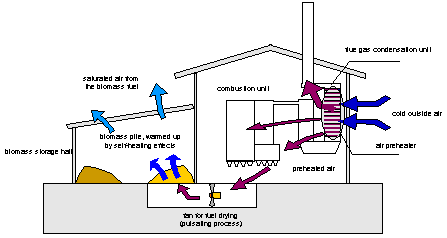Several types of pre-treatment are being applied in practice to lower handling, storage, and transportation costs, and to reduce the need to invest in very complex, robust, and expensive combustion installations.
For example, wood waste from northern Sweden is first pelletised, before it is transported to combustion installations in the south of the country.
Common pretreatment options are size reduction, compacting, drying, and washing.
 |
| Wheel loaders are often used for transporting sawdust and bark from long-term storage to the feeding system of the biomass heating plant (Courtesy of Stadtwärme Lienz, Austria) |
In order to reduce its moisture content, freshly harvested wood is often left outside for a number of weeks before it is chipped and fed to a combustion plant.
Herbaceous species such as grain straw are often left in the field and exposed to weather conditions to reduce the alkali and chlorine contents.
This way, combustion problems related to corrosion and sintering are reduced. Further fuel drying may be feasible if natural heating sources (eg solar energy) or waste heat from the combustion plant (eg from flue gas condensation units) are available.
Solid biofuels are increasingly “tailored” to the respective application process, using new upgrading methods or technologies. These can either be applied during or immediately after field production (eg leaching by rainfall or irrigation), or in a preparatory process prior to use (eg stationary leaching, use of additives, compaction). The need for such pretreatment steps depends on transportation distances, fuel prices, size of the plant, fuel-feeding mechanism applied, combustion and heat recovering technology applied, materials used, etc.
 |
| Schematic diagram of the principle of a short-term biomass drying process based on pre-heated air from a flue gas condensation unit |
With the growing market for bioenergy systems, analysing and improving fuel properties becomes increasingly important. This even extends to plant breeding and variety/clone selection. Genetic engineering, although still controversial could open up new opportunities for yield and quality improvement of biofuels.


